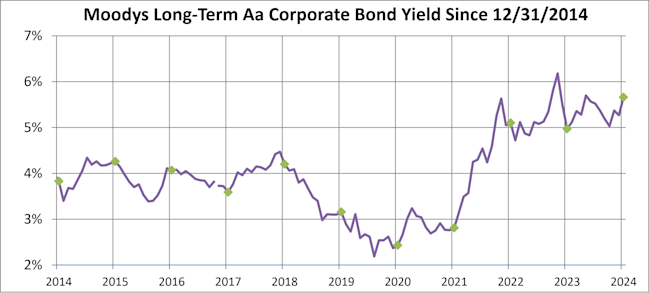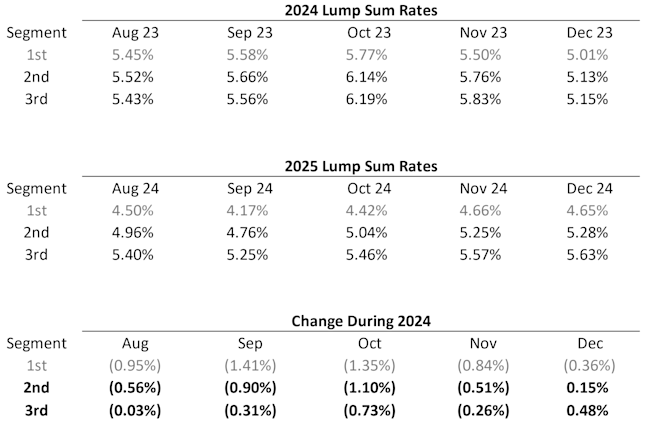De-risking in 2025 – DB lump sums
In this article we provide an analysis of a specific de-risking issue for 2025: how 2024 interest rates (generally used for valuing 2025 lump sums) may affect sponsor decisions to de-risk (or not de-risk) defined benefit plan liabilities via a lump sum window in 2025.
Interest Rates
Between 1984 and 2020, long-term interest rates declined from all-time highs (above 13%) to all-time lows (below 3%), creating, for more than 35 years, a persistent headwind for anyone involved in managing DB pensions.
Since 2020, however, rates have moved higher, briefly exceeding 6% in late 2023 before ending the year at around 5%. In 2024, rates stayed above 5%, peaking in April (at 5.7%) and ending the year at around 5.6%.

Interest Rates and Lump Sums
One impact of higher interest rates is to reduce the value of pension liabilities, including the cost of lump sums.
This plays out differently for different DB plan sponsors. Plans that include an ongoing lump sum provision (or other accelerated form of payment) must specify a “lookback month” (used to determine the lump sum valuation interest rate) and a “stability period” (to determine the period over which that rate will apply) in their plan documents.
At one extreme, a “1-month lookback” and “1-month stability period” means lump sum rates change monthly, based on the most recent rates available. For plans using this method, 2025 lump sum values will rise (or fall) with current market rates (similar to annuity purchases, which are always marked to market).
At the other extreme, a (calendar year) plan using a “5-month lookback” and “1-year stability period” used August 2023 rates to calculate lump sums for all of 2024 and will use August 2024 rates to calculate lump sums for all of 2025.
In 2025, which lookback month you use will affect lump sum cost
One feature of this approach is that, in a context of “choppy” interest rates like we’ve seen over the last two years, for plans using a “1-year stability period,” 2025 lump sum valuations will very much depend on what lookback month you are using.
Thus, as the table below shows (in more detail), August 2023 rates were marginally higher than August 2024 rates, and plans using an August lookback month will see a marginal increase in lump sum values (reflecting those lower August 2024 rates) in 2025. And, indeed, that is the case for all plans/lookback months except those using a December lookback month – the latter will see a marginal decline in lump sum values.
Bottom line: For purposes of 2025 lump sum windows in plans using a 1-month lookback/1-year stability period, plans using a December lookback month will see lower annuity values in 2025, and plans using other lookback months will see higher values.
The ability of sponsors of plans that provide for “regular” distributions in lump sum form, and use a different lookback month than December, will generally face constraints on their ability to change lump sum valuation rules.
Sponsors interested in changing their lump sum valuation method will want to discuss these issues with counsel.
Lookback months by the numbers
The table below summarizes the five sets of PPA segment rates (in effect, monthly spot rates) available for calendar year plans (August, September, October, November, and December) for 2024 and 2025 with a “1-year stability period,” and the “delta” (increase in rates for 2024 vs. 2023 lookback months) for each lookback month. (Note, “1st segment” rates are generally not significant for most lump sum calculations.)

The table below translates these rates into lump sum values for a 50 year old participant with a life annuity benefit of $100 per month payable beginning at age 65:

For calendar year plans with a 1-year stability period, 2025 lump sums for this participant are (for August-November lookback months) 4%-21% higher than 2024 lump sums, and 9% lower for plans with a December lookback month.
For plans contemplating a 2025 lump sum window that have latitude with respect to lookback month and stability period, it’s worth noting that interest rate volatility during late 2024 means different lookback months produce very different 2025 lump sum values (e.g., the September lookback month produces a lump sum 10% higher than the December lookback month).
* * *
We will continue to follow this issue.
